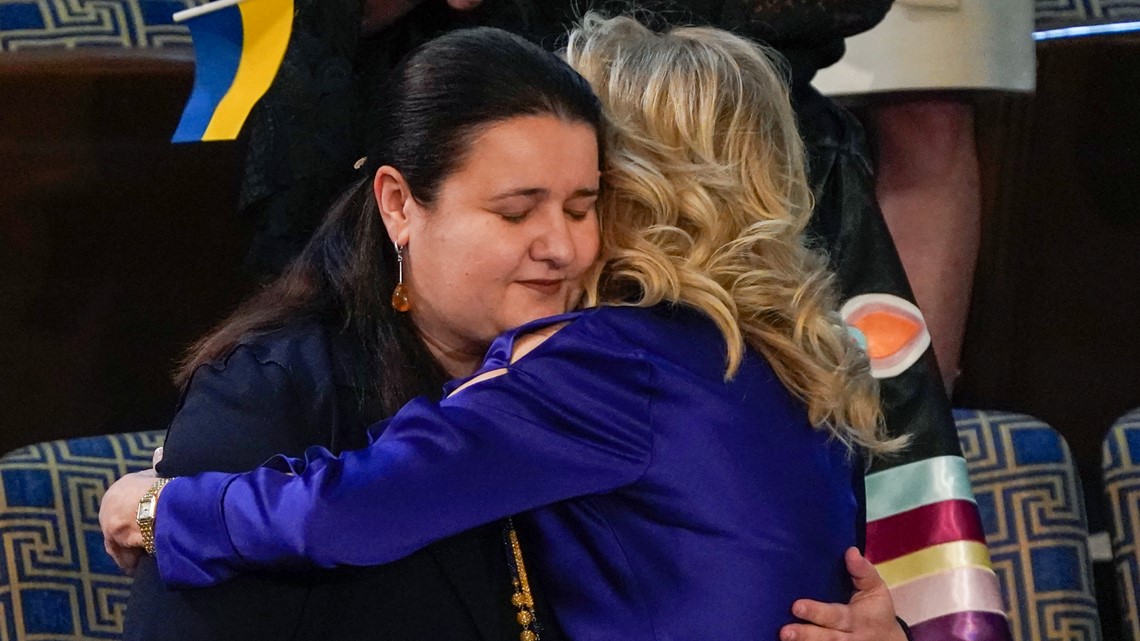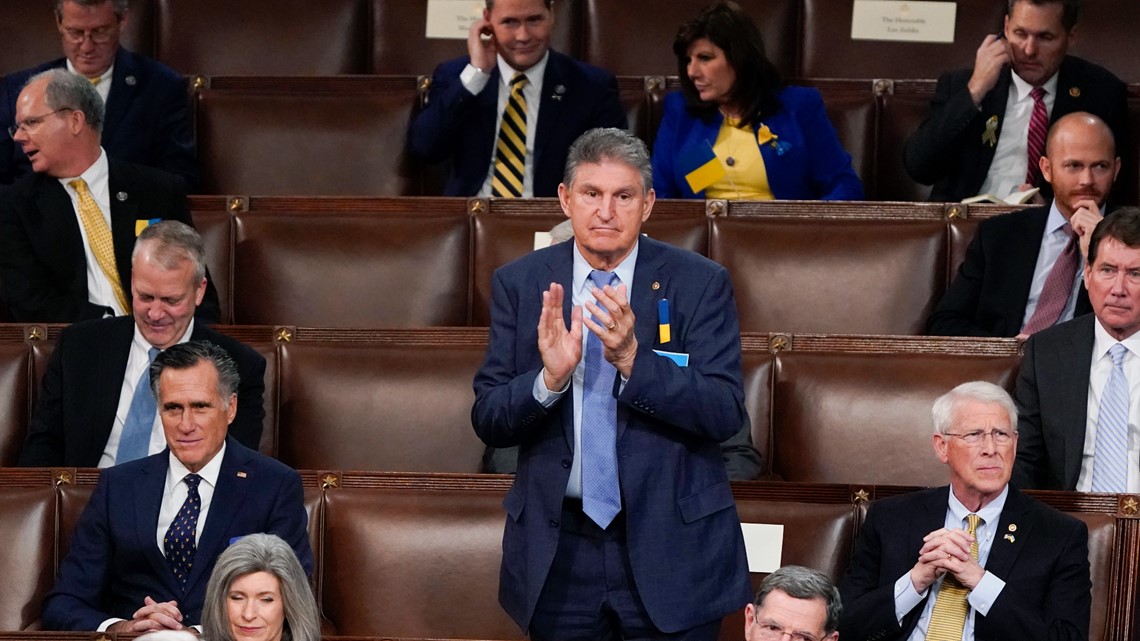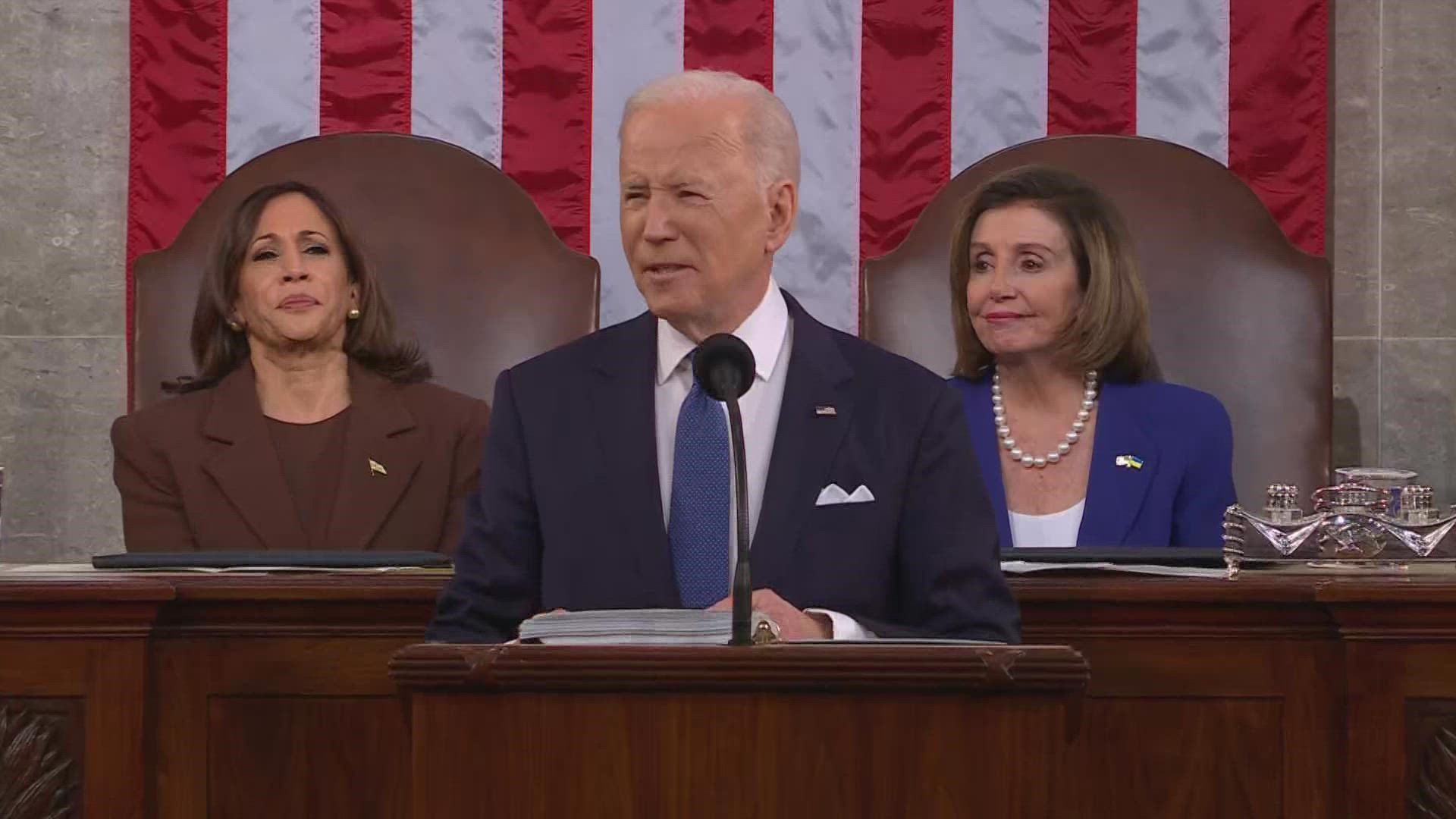WASHINGTON — Lawmakers gathered Tuesday at the heavily secured U.S. Capitol for President Joe Biden's first State of the Union address — some wearing blue and yellow ribbons and lapels in support of Ukraine — as attention turns from challenges at home to the intensifying war overseas.
It’s the first time all members of Congress were invited to the House chamber since the COVID-19 outbreak and the Jan. 6, 2021 insurrection by a mob of the former president’s supporters have largely closed the Capitol to the public. The House was full, lawmakers spread out with few pandemic face masks in sight, but the security fencing was up around the complex in a stark reminder of the nation’s divisions.
Among the few invited guests, Ukraine’s ambassador to the United States, Oksana Markarova, was welcomed with a standing ovation as she waved her country's flag and was hugged by first lady Jill Biden in the visitor's gallery.
The challenge for the president, and the lawmakers listening from the chamber, will be to address the worsening war abroad while confronting difficulties at home.
“My fellow Americans, last year COVID-19 kept us apart,” Biden said as he opened his speech, "but this year we’re finally together again."
The event, usually held in January, provides the president an opportunity to outline his agenda for the year ahead, a tradition launched by George Washington's written message more than 200 years ago.
For Biden, this first State of the Union speech arrives amid the backdrop of a war, following Russia's invasion of Ukraine, and a number of legislative defeats for the Democratic president and his allies on Capitol Hill.


Signs of partisan tensions flared as soon as Biden touted his $1.9 trillion COVID-19 relief package, which not a single Republican supported as Democrats passed it through Congress last year.
“It worked,” Biden said loudly, as Republicans murmured boos and Democrats jumped to their feet to applaud — Senate Majority Leader Chuck Schumer eagerly jumping twice to clap approval.
In one of the most dramatic outbursts of the evening, Rep. Lauren Boebert of Colorado blamed Biden for the deaths of 13 service members killed in the chaotic withdrawal from Afghanistan.
“You put them in — 13 of them,” Boebert yelled. At the time, Biden was talking about the death of his son, Army Maj. Beau Biden, and legislation to support veterans exposed to toxic fumes from military burn pits used to get rid of waste and equipment.


While his administration’s response to Russian aggression in Europe has been met with rare and remarkable bipartisan support, the division between the two parties in Congress is palpable, even among factions of Democrats.
One Democrat, Sen. Joe Manchin of West Virginia, who almost singularly tanked Biden’s “Build Back Better” domestic agenda of social spending and climate change programs, sat on the Republican side of the aisle.


Several Republican lawmakers skipped the speech altogether. Republican Sen. Marco Rubio of Florida said he didn't want to engage in the “theater" of coronavirus protocols when all attendees were required to have a COVID-19 test. Several Democrats tested positive and had to stay home.
Biden began his speech focusing on the crisis in Ukraine, a moment of common ground that drew a number of standing ovations from Republicans.
As the evening moved from foreign to domestic policy, the partisan divide deepened — Democrats cheering Biden’s long list of legislative priorities, from voting rights to free community college, while Republicans sat silently, some mouthing their displeasure.
And no applause was as loud or in unison as when the president said: “The answer is not to defund the police,” when talking about his plans to address gun violence and police brutality. One Republican, Rep. Marjorie Taylor Greene, stood with her party and yelled, “Yes!”
Biden thanked retiring Supreme Court Justice Stephen Breyer — who put his hand on his heart and acknowledged the applause — and urged confirmation of his nominee, federal judge Ketanji Brown Jackson.
But as he charts the year ahead, even Biden’s suggestion they could come together on his “unity agenda” fighting opioid addiction and helping veterans may face difficulty in the harshly divided Congress.
“His only mandate was to govern from the middle,” Senate Minority Leader Mitch McConnell said on the floor Tuesday afternoon. “But for the past year, he and his administration have often behaved like they’re trying to fail their own test.”
The audience inside the House chamber is much larger than the 200 allowed last year due to pandemic restrictions but much smaller than the usual 1,600 that typically includes special guests of lawmakers who this year were not granted extra tickets. The first lady's other guest was Frances Haugen, the former Facebook employee who exposed what the company may have known about damage caused by its social media platforms.
The address follows a much more limited joint address Biden delivered last year, shortly after his inauguration amid the fast-spreading Delta variant of the coronavirus and his predecessor Donald Trump's second impeachment over the Capitol insurrection.
This year, House Speaker Nancy Pelosi welcomed every member of Congress to attend, but with some COVID-19 restrictions in place. But in the last week, the mask mandate was done away with as the Centers for Disease Control and Prevention announced new guidelines.
Other Republican lawmakers, including Rep. Chip Roy of Texas and Rep. Thomas Massie, R-Ky, said they would not be attending because of the COVID-19 requirements.
For others, including Rep. Lou Correa, D-Calif, it was their first time spread out in the House visitor galleries since they sheltered during the Jan. 6 2021 siege, when Trump supports attacked the Capitol trying to stop Congress from certifying Biden's election.
But Biden also has conflicts to sort through within his own party. Progressive Rep. Rashida Tlaib, D-Mich., is delivering the Working Families Party response, in which she is expected to call out Biden and Senate Democrats for not passing his $1.8 trillion social spending plan last year.
The planned speech by another Democratic member to a Democratic president’s address is the latest example of the inner fighting among factions of the majority party, most recently between centrists and progressives like Tlaib.
___
Associated Press writer Darlene Superville contributed to this report.

